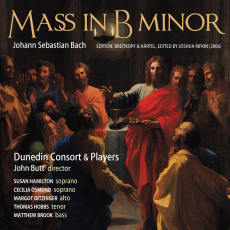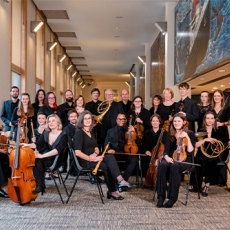Bach Mass in B Minor - Dunedin Consort - Audio Video Club of Atlanta
This new account of J.S. Bach's Mass in B Minor by the Dunedin Consort under director John Butt is notable for reasons other than the sheer spiritual beauty of the performance (which it has). It represents the most recent thoughts of the present school of performance considerations. That, in turn goes back at least as far as 1981, when American scholar Joshua Rifkin first proposed the theory that Bach's great choral masterworks were composed with the idea of having one singer per vocal part. That idea was generally scoffed at then, but it has since gained credence in the early music community. Rifkin himself, besides demonstrating these ideas in concert and on records with his own Bach Ensemble, prepared what is alleged to be the first scholarly edition of the B-Minor Mass. It is this edition, published by Breitkopf & Härtel (2006), which is recorded here for the first time.
In practice, this means that you have five solo vocalists, known as "concertists;" in this recording they are Susan Hamilton, soprano I; Cecilia Osmond, soprano II; Margo Oitzinger, alto; Thomas Hobbs, tenor; and Matthew Brook, bass. When not singing as soloists, they drop back into the five-member supporting ensemble, known as the ripieno by analogy with the form of a concerto grosso. The instrumental forces are scaled back accordingly from what one would need to accompany a larger body of singers. In fact, "accompaniment" would be a foreign notion here, since the idea is that of voices and instruments singing together, rather than singers supported by an orchestra such as we have in the great choral works that have been the rule since Bach's day. It explains also why its vocalists are apt to be regular members of the group, as we have here with the Dunedin Consort, rather than famous stars of the opera and the concert stage: this sort of set-up would do nothing for their careers.
Taken on its own terms, the present performance is quite lovely and aesthetically satisfying. Differences between this and those prior to the 2006 edition are small enough to avoid detection at a casual listening, but include such features as the use of two flutes instead of one to support the charming soprano/tenor duet "Domine Deus" (O Lord God) and the addition of two bassoons to fill out the harmony provided by Anneke Scott's glorious horn playing under the bass aria "Quoniam to solus scanctus" (For Thou only art holy). Brook is a bit nasal here, but he atones in the Creed with a really authoritative rendering of "Et in spiritum sanctum" (and in the Holy Ghost). In the "Resurrexit" the soprano line cuts through the splendid contrapuntal chorus with searing intensity. Credit Hobbs with some fine work in the "Benedictus" and also Oitzinger in the "Agnus Dei" (Lamb of God), both of which carry much of the timeless message of the Mass.
This recording will provide abundant pleasure to Bach lovers, and especially advocates of current performance styles.

